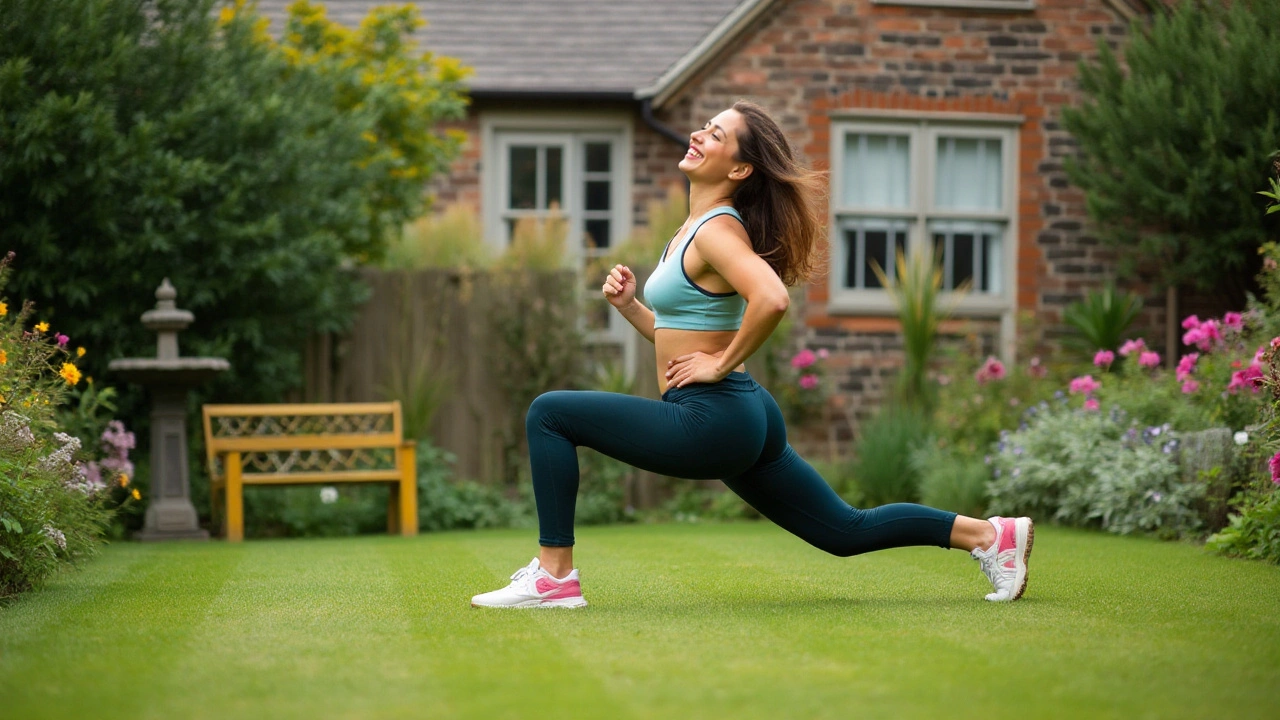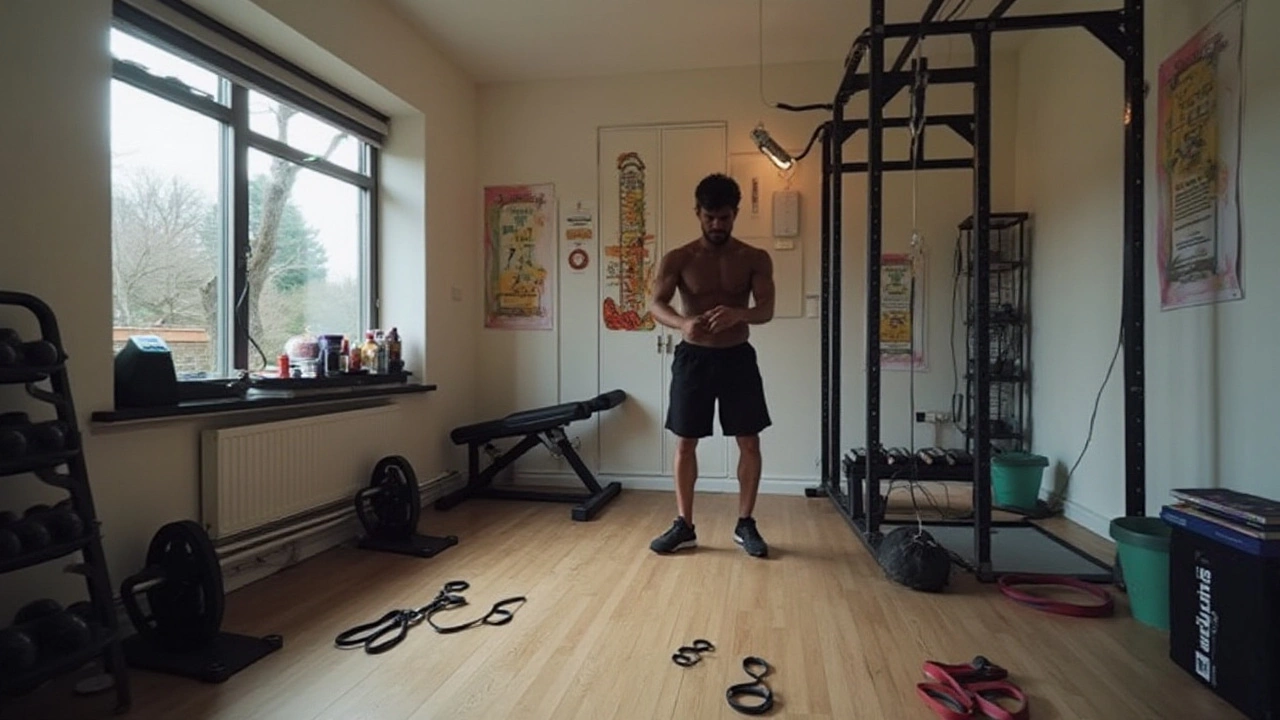
When you think about exercising at home, the options can seem a bit overwhelming. But what if there was a magic bullet, the single-best move that could work wonders for your entire body? You might be surprised to learn that such an exercise exists, often overlooked due to its simplicity and intensity.
This article delves into a straightforward yet highly effective workout that packs a punch, stimulating multiple muscle groups and improving cardiovascular health. It doesn't require a gym membership or fancy equipment, but it does promise a heart-pumping, sweat-inducing session with just a small space needed. We'll explore ways to tailor it to fit both beginners and seasoned athletes, ensuring everyone finds their groove with this powerhouse of a move.
- Understanding Full-Body Workouts
- The Benefits of Burpees
- Modifying Exercises for All Levels
- Creating a Balanced Routine at Home
- Staying Motivated and Consistent
Understanding Full-Body Workouts
Full-body workouts are an incredible way to engage multiple muscle groups in a single session, maximizing efficiency, especially for those juggling busy schedules. The essence of a full-body workout lies in its design to target not just one part of the body, but both the upper and lower extremities, including your core. This ensures that every session feels balanced and comprehensive, helping you build strength evenly across your frame. The popularity of home workouts has soared, not because they are easy, but due to their flexibility and convenience. When crafted carefully, a full-body routine can offer similar or even superior benefits compared to traditional gym sessions. The beauty of these exercises is that they vary widely, from simple bodyweight movements to those that incorporate equipment like dumbbells or resistance bands.
The science behind full-body exercises is both simple and profound. By engaging multiple muscles at once, you effectively elevate your heart rate, simulating cardio activity while also toning the body. This dual action helps boost metabolism, making the body more efficient at burning calories even after the workout has concluded, a phenomenon known as the afterburn effect. An informed approach considers the compound nature of full-body exercises. For example, classics such as burpees have earned their reputation for delivering intense cardio while engaging everything from your quads to your shoulders and core.
In a full-body workout, remember the golden rules of balance and variety. Balance involves ensuring that both push and pull muscles are adequately worked, maintaining harmony in strength and flexibility across different muscle groups. Meanwhile, variety keeps the workout engaging and prevents muscle adaptation, which can plateau progress. You could maintain interest and enthusiasm by integrating diverse movements or trying new challenges periodically. As recognized trainer Jillian Michaels puts it,
"Exercise is about doing what you can, not what you can't. It's the spirit that defines your limits.”Her words encourage incorporating achievable challenges step by step, ensuring that each session contributes towards a strong, cohesive whole.
For many fans of home workouts, the allure lies in the minimal equipment required. Most full-body exercises rely heavily on body weight, which makes them not only cost-effective but also accessible for beginners. More seasoned exercisers seeking additional intensity might turn to hand weights or resistance bands, which can be easily stored at home. Continuously modifying and adjusting the weight or resistance level ensures that the routines evolve in parallel with growing strength. As you contemplate your home workout journey, remember that effective routines are developed not just for peak physical performance but also for a better understanding of personal body dynamics. Embrace the full range of motion in movements to reduce injury risk and improve joint flexibility. By choosing exercises that challenge every major muscle group, you're crafting a path to holistic health right in your living room.
The Benefits of Burpees
Burpees are often dubbed the 'king of full-body exercises' for a reason. This dynamic workout move offers a powerful combination of cardiovascular and strength training, making it a favorite among those seeking an efficient exercise routine. When you execute a burpee, you're not just targeting one or two muscles; you're engaging multiple muscle groups from head to toe. From the squat that fires up your thighs and glutes to the push-up that tones your arms, chest, and core, each element of the burpee works harmoniously to enhance your body’s muscular strength and endurance.
Moreover, burpees are highly effective in boosting your heart rate, offering an excellent cardiovascular workout. This vigorous exercise can help improve your oxygen intake, making your heart and lungs more efficient. It's also known for its calorie-torching abilities, meaning you can burn a significant amount of calories in a relatively short period. Incorporating burpees into your home workout routine can be a game changer, especially for those looking to maximize their efforts in limited time.
Interestingly, the humble burpee has a rich history. Developed in the 1930s by Royal H. Burpee, a physiologist who was creating a quick and straightforward fitness test for his PhD thesis, this exercise was eventually adopted by the U.S. Armed Services during World War II to assess the fitness level of recruits. This backstory adds an extra layer of appeal to the burpee, as it not only stands the test of time but was once used to measure peak physical condition.
"Burpees take you back to fundamentals: your body is your gym," says Dr. Steven Blair, a respected physical activity expert. "They are an all-in-one test of balance and coordination."
The beauty of burpees lies in their simplicity and lack of equipment. All you need is a small area of space and your body weight, making them an accessible option for anyone, anywhere. This flexibility is particularly appealing in a home workout setting, where space and resources can often be limited. Moreover, because burpees can be modified to match different fitness levels, they can be tailored to meet individual capabilities and goals. Whether you're a beginner easing into exercise or an athlete pushing for peak performance, burpees can adapt to suit your needs.

Modifying Exercises for All Levels
Achieving a complete full-body exercise experience at home requires understanding how to adjust workouts to fit individual abilities while keeping them challenging enough to incite progress. When it comes to home workouts, customization is key. Tailoring exercises depending on your fitness level not only prevents injury but also promotes steady improvement, making the journey more enjoyable. Whether you're a beginner or an advanced enthusiast, there's always room to elevate your workout regimen.
For those just starting their fitness journey, foundational body movements with minimal resistance serve as a good starting point. Begin with streamlined versions of complex maneuvers, like wall push-ups for those who are intimidated by traditional ones, or squats using a chair for balance support. Beginners should focus on form over quantity, ensuring every movement is executed with precision, protecting joints and muscles from unnecessary strain.
As one progresses, intensifying these exercises keeps the body guessing and muscles growing. Intermediate exercisers might incorporate moderate resistance through resistance bands or light weights, which intensify the challenge without sacrificing form. Adding repetitions or decreasing the rest between sets can also ramp up the energy expenditure, pushing the body towards greater endurance and strength.
For seasoned individuals, modifications involve adding plyometrics or high-intensity intervals to exercises, making them not only more challenging but effective at enhancing cardiovascular efficiency. Utilizing equipment like kettlebells or weight vests during burpees can offer the variety seasoned athletes need to break through plateaus.
Did you know? According to a 2023 fitness survey, about 68% of regular exercisers changed their workout regimen every two months to keep their routine from becoming stagnant, thereby enhancing their motivation and results.
Regardless of your fitness level, remember that the core principle is consistency intertwined with variety. As fitness guru Jillian Michaels famously said,
"Transformation is not a future event. It is a present activity."This means your focus should be on what can be achieved today, with what you have, and how it can be improved continuously.
Creating a Balanced Routine at Home
Finding the right blend of exercises can make your home workout routine not only effective but also enjoyable. Whether you're focusing on a full-body workout or targeting specific areas, balance is key to ensuring that each session maximizes your effort while minimizing the risk of injury. A balanced routine involves combining cardio, strength, flexibility, and recovery exercises. For beginners, a mix of dynamic stretches serves as an effective warm-up—initiating your workout and reducing the likelihood of strains.
Start by identifying what makes an exercise effective—a principle well illustrated by burpees. This potent exercise, celebrated for its adaptability and intensity, works your full-body by engaging arms, legs, and core, and it elevates your heart rate into the cardio zone. Yet, the magic of a burpee lies in its simplicity; you need no more than a bit of space, which seamlessly blends into any home setting. For added variety, alternate burpees with other compound movements like push-ups and squats, enhancing your session's efficacy. These foundational exercises should serve as the core of your workout to engage a broad range of muscles efficiently.
Staying Motivated in Your Home Journey
Motivation can sometimes wane when exercising at home. Try setting realistic goals and establishing a consistent schedule to maintain momentum, utilizing tools like online workout trackers to monitor your progress. According to a sports scientist, "Tracking your improvements can significantly boost your morale and help maintain a consistent routine." By setting concrete milestones, you can measure your progress and stay encouraged by visible results. Additionally, mix your routine with different workout styles, such as yoga and pilates, to enhance flexibility and prevent monotony.
Consider incorporating rest days in your weekly plan to allow your muscles to recover and repair. This recovery phase is crucial and often the step that many overlook when planning a home workout. Aim for at least one full day of rest each week, or if you're following more intensive routines, try every three to four days. By including meditative activities or leisurely walks during these rest periods, you'll maintain an active lifestyle without overburdening your body.
Ultimately, crafting a balanced routine is about listening to your body and adjusting your workout as needed while striving towards your fitness goals. Emphasize consistency, variety, and proper rest. Don't be afraid to modify exercises to suit your level, or even break workouts into shorter sessions to fit into your daily schedule seamlessly. Trust your instincts, and remember—your fitness journey is a marathon, not a sprint, and the balance you create in your routine at home is both a journey and a powerful tool for your personal well-being.

Staying Motivated and Consistent
We've all been there: gung-ho about a new fitness routine, full of vigor the first week, only to find our enthusiasm waning as time stretches on. Staying motivated on your journey with home workouts is key to seeing real progress. The comfort of your home can sometimes lull you into skipping a session or two. But don't worry—it happens to the best of us. One powerful way to maintain your motivation is by setting realistic, attainable goals. Research has shown that people who set clear, achievable objectives are more likely to stick with their exercise routines. This doesn't mean you have to aim for something grandiose right out the gate. Instead, start small, and gradually build up as you witness your progress.
Create a consistent schedule, ideally aligning your workout time with the moments you're most energized. For some, it means getting active first thing in the morning, for others, it's an evening session that fits best. The flexibility of home workouts is exactly what makes them so appealing—choose a time that serves you. Marking these times on a calendar not only acts as a visual reminder but also reinforces your routine as sacred. Another trick that has proven benefits is pairing workouts with a habit you already love. This could be anything from listening to your favorite podcast, watching your beloved series, or even a post-workout reward like a nourishing smoothie.
To prevent monotony, spice up your routine by incorporating different full-body exercises into your week. It's important to keep things fresh and varied; otherwise, boredom can sneak in. Join online communities or engage with friends who also enjoy home workouts. Sharing progress and challenges with others fosters a sense of accountability and provides that extra push needed on days when motivation is low. A motivational partner can significantly increase your chances of sticking to your regimen. According to a study published in the Journal of Sports Medicine, people who exercised with a partner had a higher attendance rate than those who exercised alone.
"Motivation is what gets you started. Habit is what keeps you going." – Jim Ryun
Don't discount the power of self-reflection and reward. Keeping a fitness journal or using an app to track your progress can offer incredible insights into your journey. Look back to see how far you've come, and celebrate those milestones. Whether it's an improvement in your stamina, strength, or even just the routine itself feeling easier—these are moments worth appreciating. Rewards don't always have to be food-related; they can be a new workout gear or a quiet hour of relaxation. Above all, practice patience and be kind to yourself. Some days will be harder than others, and that's perfectly fine.
